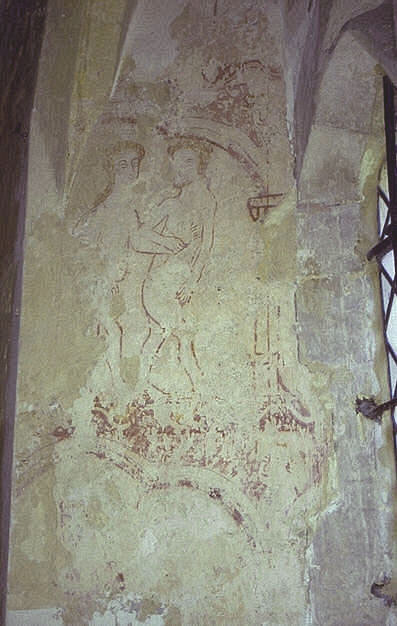Kelmscott, Oxfordshire (†Oxford) C.1280
Expulsion from Paradise

This is the only clearly identifiable scene among those painted in the splays of and above a window in the north chapel of the church at Kelmscott. One of these, above the window, may be an early and now very fragmentary Doom, thus associating the Original Sin of Adam and Eve with the eventual judgement of all humankind. The two figures, both naked, Adam with a beard on the right and Eve with long loose hair on the left, are surmounted by an ornamental canopy, a detail repeated in all the scenes at Kelmscott. The upper part of a similar canopy can be seen below Adam and Eve – below it was probably an earlier scene in their disobedience; nothing apart from a few pigmented patches remains of it now. Above the two figures is another faint and fragmentary scene, possibly God delivering the sentence of expulsion or the angel with the fiery sword, but more likely, I think, a supplicating figure belonging to the Doom.
It is hard to decide whether Adam is holding Eve’s hand, or grasping her firmly by the wrist, but whichever it is, the two figures are touching in their naked vulnerability and the simplicity with which they are painted. Adam’s face bears a strong resemblance to that of the mounted Magus in the contemporary Adoration of the Magi at Black Bourton only a few miles away. Not enough, I think, to claim that the same painter was responsible for both, but intriguing all the same.
To the left on the west wall of the chapel is the story of Cain and Abel. Opposite that, on the east wall and now on the site, are two paintings of scenes from the Infancy of Christ – identifiable, I think, as the Massacre of the Innocents and the Presentation in the Temple. There is some decorative painting in the nave of the church and a small 15th century panel of St George (the church is dedicated to him) in stained glass. Kelmscott was the church of the English designer William Morris, who lived at neighbouring Kelmscott Manor. He looked with a jaundiced eye at over-restored medieval churches and in 1877 founded the Society for the Preservation of Ancient Buildings as a result. He certainly played a part in ensuring that the essential repairs to and restoration of the church in the late 19th century were as discreet and careful as they could be.
† in page heading = Diocese